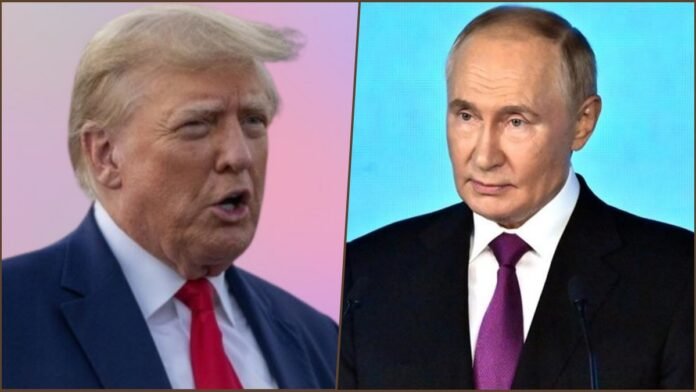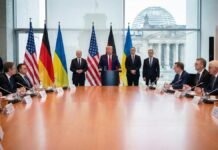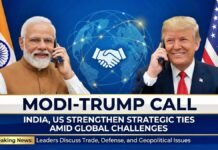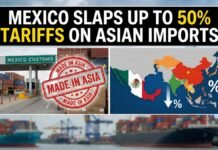
Key Points
- President Trump threatens up to 155% import duties on Chinese goods if bilateral trade deal fails
- Announcement made during White House meeting with Australian PM Anthony Albanese on October 21, 2025
- Trump confirms upcoming meeting with Chinese President Xi Jinping in South Korea within weeks
- US-Australia sign major agreement on rare earth resources cooperation
- Global markets experience volatility following tariff threat announcement
- Chinese state media dismisses statement as “political stunt” while government monitors situation closely
- Experts warn of potential price increases for American consumers on electronics, clothing, and toys
New Delhi: President Donald Trump has escalated trade tensions with China, threatening to impose import tariffs as high as 155% on Chinese products if negotiations for a bilateral trade agreement collapse. The announcement, made during a high-profile White House meeting on October 21, 2025, has sent shockwaves through global financial markets and reignited fears of a full-scale trade war between the world’s two largest economies.
White House Meeting Sets Stage for Tariff Threat
Trump unveiled his hardline position while hosting Australian Prime Minister Anthony Albanese at the White House, where the two leaders formalized a strategic agreement on rare earth minerals cooperation. The timing of the tariff announcement alongside the Australia deal underscores America’s efforts to diversify its supply chains away from Chinese dominance in critical resources.
“I think we’re going to have a great trade deal with China,” Trump stated during the joint press conference. “This deal will be beneficial for both countries and the entire world.” Despite the optimistic framing, the President’s simultaneous threat of unprecedented 155% tariffs revealed the high-stakes brinkmanship characterizing current US-China relations.
Diplomatic Opening Amid Economic Threats
In an apparent attempt to balance confrontation with dialogue, Trump announced plans to meet Chinese President Xi Jinping within the coming weeks, with South Korea emerging as the likely venue. The meeting would mark the first face-to-face encounter between the two leaders since Trump’s return to the presidency in January 2025.
The proposed summit carries enormous significance as both nations navigate complex economic interdependence while competing for global influence. Trump’s strategy appears designed to maximize negotiating leverage ahead of direct talks with Xi, using tariff threats as a bargaining chip to extract concessions from Beijing.
Rare Earth Resources Agreement
The US-Australia agreement signed during Albanese’s visit represents a strategic counter to China’s dominance in rare earth elements, which are crucial for manufacturing electronics, renewable energy technologies, and defense systems. Australia possesses significant rare earth reserves and processing capabilities, making it an ideal partner as Washington seeks to reduce dependence on Chinese supply chains.
This minerals cooperation framework aims to establish secure, diversified sources for materials essential to America’s technological and military superiority. The agreement includes provisions for joint processing facilities, research collaboration, and guaranteed supply arrangements.
Market Reaction and Economic Implications
Global financial markets responded immediately to Trump’s tariff threat, with major indices experiencing volatility. The Dow Jones Industrial Average, S&P 500, and Nasdaq all registered fluctuations as investors processed the implications of potential trade disruptions. Asian markets showed particular sensitivity, with export-dependent economies facing heightened uncertainty.
Currency markets also reacted, with the Chinese yuan weakening against the dollar on concerns about reduced export competitiveness. Commodity prices for industrial metals and energy showed mixed movements as traders assessed supply chain risks.
The threat of 155% tariffs represents an unprecedented escalation beyond even the highest duties imposed during Trump’s first term. Economic analysts warn that such extreme tariff rates would effectively function as an import ban, severing established trade relationships and forcing fundamental restructuring of global supply networks.
Consumer Impact Concerns
American consumers stand to bear significant costs if Trump’s tariff threats materialize. China remains the dominant supplier of numerous consumer goods categories, with extreme market positions in electronics, clothing, footwear, toys, and household items.
Industry experts project that 155% tariffs would translate into substantial retail price increases. A smartphone currently retailing for $800 could potentially cost over $2,000 with the full tariff burden passed to consumers. Similar multiplier effects would affect everything from children’s toys to home appliances.
Retailers including major chains and e-commerce platforms have begun contingency planning, exploring alternative sourcing options in Vietnam, India, Bangladesh, and Mexico. However, switching suppliers requires time, capital investment, and operational adjustments that cannot occur overnight.
China’s Response and Strategic Position
Chinese authorities have not issued an official government response as of October 21, 2025, though state media outlets quickly characterized Trump’s statement as a “political stunt” designed for domestic consumption. The China Daily and Global Times published editorials dismissing the tariff threat while warning of reciprocal measures should Washington proceed with implementation.
Behind the scenes, Chinese government officials are reportedly taking the threat seriously, convening emergency meetings to assess response options and economic vulnerabilities. Beijing possesses multiple retaliatory tools including tariffs on American agricultural products, restrictions on rare earth exports, and potential complications for US companies operating in China.
China’s Ministry of Commerce has maintained public silence, likely awaiting clearer signals about Trump’s actual intentions versus negotiating posturing. Chinese leadership under Xi Jinping has demonstrated consistent preference for strategic patience over reactive escalation in recent years.
Trump’s Trade Policy Track Record
This latest tariff threat represents continuity with Trump’s first-term approach to China trade policy. Between 2018 and 2020, the Trump administration imposed tariffs on approximately $370 billion worth of Chinese imports, triggering reciprocal Chinese tariffs on American goods totaling roughly $170 billion.
That initial trade war produced mixed results. While some manufacturing returned to the United States and American allies, overall trade deficits with China remained elevated. Many businesses absorbed tariff costs through reduced profit margins rather than reshoring production, while American farmers suffered from lost Chinese market access for soybeans, pork, and other agricultural exports.
Since returning to office in January 2025, Trump has pursued an aggressive tariff agenda extending beyond China. His administration has implemented or threatened duties on imports from the European Union, Mexico, Canada, and other trading partners, arguing that America has been exploited through unfair trade practices for decades.
Global Economic Ripple Effects
The prospect of renewed US-China trade conflict extends far beyond the bilateral relationship. China’s integration into global supply chains means disruptions would cascade through multiple economies and industries.
Countries serving as intermediate manufacturing hubs including South Korea, Taiwan, Vietnam, and Thailand face particular exposure. These nations import components from China for assembly before exporting finished products to the United States. Tariff escalation could render entire supply chain models economically unviable.
European economies also confront challenges. Major European companies including automotive manufacturers, luxury goods producers, and industrial equipment makers maintain significant operations in China serving both the domestic Chinese market and export production. Trade war escalation could force difficult choices about market prioritization.
India’s Position and Concerns
Indian policymakers are monitoring developments with concern despite not being directly targeted. India seeks expanded trade relationships with both the United States and China while navigating complex geopolitical alignments. A full-scale US-China trade war could create opportunities for Indian manufacturers to capture market share but also risks broader global economic slowdown that would reduce demand for Indian exports.
Indian technology, pharmaceutical, and textile sectors have positioned themselves as alternative suppliers for American buyers seeking China diversification. However, India’s infrastructure limitations and relatively higher labor costs compared to Southeast Asian competitors present challenges for rapid supply chain reorientation.
Expert Analysis and Projections
Economists remain divided on whether Trump’s 155% tariff threat represents genuine policy intent or aggressive negotiating tactics. Some analysts argue the extreme figure exceeds any plausible implementation scenario, suggesting it functions primarily as psychological pressure ahead of Xi Jinping talks.
Others warn against dismissing Trump’s statements as mere bluster, noting his first-term willingness to follow through on controversial trade actions despite widespread opposition from business groups and economic advisers. The President’s political base strongly supports tough China policies, creating domestic incentives for escalation.
International trade organizations including the World Trade Organization (WTO) have expressed concern about unilateral tariff actions violating established multilateral frameworks. However, enforcement mechanisms remain limited, particularly when major powers pursue policies outside WTO parameters.
Looking Ahead
The coming weeks will prove critical as Trump’s team and Chinese counterparts engage in preliminary negotiations ahead of the proposed Xi Jinping summit. Both sides face domestic political constraints limiting compromise options while sharing economic incentives to avoid worst-case scenarios.
Financial markets will continue monitoring developments closely, with volatility likely persisting until greater clarity emerges about actual policy implementation timelines and scope. Corporate executives must balance short-term uncertainty with long-term strategic planning for an increasingly fragmented global trading system.
The October 21 tariff announcement marks another chapter in the evolving US-China relationship that will shape global economic architecture for years to come. Whether Trump’s threats materialize into policy reality or resolve through negotiated settlement, the willingness to deploy such extreme leverage signals fundamental shifts in how major powers approach economic statecraft in the 21st century.


















































